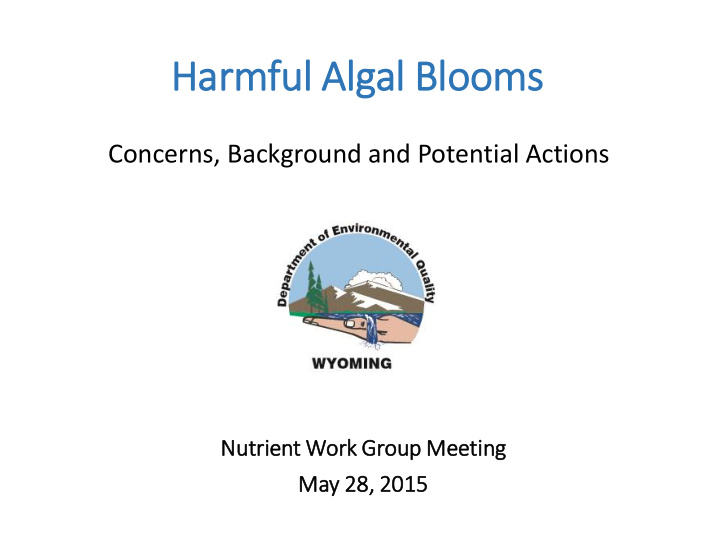



Harm armful Alg lgal l Blo looms Concerns, Background and Potential Actions Nu Nutr trie ient Wor ork Grou oup Meetin ting May 28, 2015
Presentation Outline • Background on Harmful Algal Blooms (HABs) • Potential Blooms in Wyoming • Potential Actions • Harmful Algal Blooms in Drinking Water Supplies Ecan.govt.nz • Questions? Waterboards.ca.gov Communitypetclinic.net
Concerns About Algal Blooms • DEQ Water Quality Laboratory has received periodic inquiries regarding algal blooms in reservoirs used for recreation • Lab does not have a process to test for harmful algal blooms • DEQ does not have a process for responding to citizen complaints about algal blooms • Need for an Action Plan Dec.ny.gov Landcareresearch.co.nz
Harmful Algal Blooms • Dense overgrowths of “algae” Actually cyanobacteria (blue-green algae) Can be found throughout water column Accumulations form scums or colonies Not all algal blooms are harmful! Whoi.edu
Cyanotoxins from HABs • Health consequences for people and animals Dermatoxins, hepatotoxins, neurotoxins Pets and livestock: can die from consuming toxins Humans: nausea fatigue disorientation Ncwtv.com rashes distressed bowels seizures paralysis Blog,dhec.co.za
Bloom Forming Cyanobacteria WY • Four genera that have produced blooms (>100,000 cells/liter) in Wyoming lakes/reservoirs: Anabaena Anabaena Aphanizomenon Aphanizomenon Aphanocapsa Microcystis Micrographia.com Pixgood.com Microcystis Aphanocapsa Fmp.conncoll.edu Algalweb.net
Bloom Forming Cyanobacteria WY
Potential Cyanotoxins in WY • These genera produce the following toxins: Microcystin Cylindrospermopsin Saxitoxin Anatoxin Sjp.ac.lk WDEQ Uncw.edu
What Causes HABs to Form? • Excess nutrients • Low-water or low-flow • Sunlight and wind • Warmer temperatures • Low salinity Ian.umces.edu
Action Plan for Recreational Waters • Collaborative Effort? Wyoming Department of Environmental Quality Wyoming Department of Health Game and Fish Wyoming State Parks Lake and Reservoir Management Agencies Other State Agencies? WDEQ
Action Plan for Recreational Waters • Public outreach and information • Process for responsive monitoring • Procedures for issuing warnings, advisories, closures? WDEQ
Action Plan for Recreational Waters • Public outreach and information What are HABs What to look for? What to do if you suspect a HAB (who to call, don’t recreate)? Where to display this information (parks, fishing regulations, other places)?
Action Plan for Recreational Waters • Process and procedure for responsive monitoring Who collects samples? What to collect (cyanobacteria, cyanotoxins, chlorophyll a)? How quickly should sampling occur following call? Who analyzes the data? Marine.Rutgers.edu Mtu.edu
Action Plan for Recreational Waters • Procedures for issuing warnings, advisories, closures? At what concentrations, densities would warnings, advisories, closures be issued? Who issues warnings, advisories, waterbody closures? How is this information disseminated to the public? When would an warning, advisory, waterbody closure be lifted, frequency of monitoring, types of monitoring? Mdpi.com
Next Steps • Determine who will collaborate on the plan • Determine when to meet • Work out details of public outreach, monitoring, analysis, advisories, etc. • Finalize the HAB Action Plan for Recreational Waters WDEQ
HABs in Drinking Water Supplies • HABS and/or cyanotoxins can impact public waters supplies Toxins are not removed during conventional drinking water treatment Currently, there are no maximum contaminant levels under the Safe Drinking Water Act for cyanotoxins EPA did release draft action levels for cyanotoxins on May 6, 2015 Microcystin 0.3 ppb for Children 1.6 ppb for Others Cylindrospermopsin 0.7 ppb for Children 3 ppb for Others Pixgood.com
HABs in Drinking Water Supplies • EPA has primacy over the Safe Drinking Water Act/public waters supplies in Wyoming • Is monitoring for HABs and/or cyanotoxins occurring in public water supply reservoirs? • Should monitoring for HABs and/or cyanotoxins be occurring? • What types of monitoring should occur? • Is each drinking water supply responsible for monitoring or does DEQ need to be involved in those efforts? • Do we need an action plan in place for monitoring for HABs and/or cyanotoxins in public drinking water supplies?
HABs Workshop • EPA is hosting a Harmful Algal Bloom Workshop September 30 th and October 1 st • • Rapid City, SD • Workshop will address recreational impacts and drinking water impacts • Would be great for partner agencies to attend (Health, Drinking Water, Other Interested Groups)
Que uestio ions? Lindsay Patterson Watershed Protection Program Surface Water Quality Standards lindsay.patterson@wyo.gov 307-777-7079
Recommend
More recommend